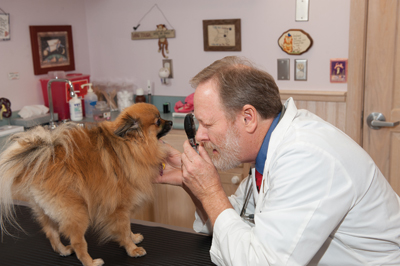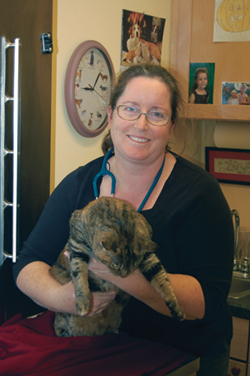Solo practitioners see a place for themselves
A solo companion animal practitioner in Norwalk, Ohio, considers himself to be following a "core veterinarian" model with a practice team. A solo companion animal practitioner outside Philadelphia runs a house call business in addition to her regular office. A solo companion animal and equine practitioner in Killdeer, N.D., plans to add a partner to expand her business to food animals.
Solo practice is no longer the norm in private practice and has become somewhat of a niche in companion animal practice specifically, but these three veterinarians are examples of many who see a place for this practice model.

Among all private practices, the proportion of solo practices decreased from 52.6 percent in 1999 to 38.1 percent in 2009, according to the AVMA Biennial Economic Survey. Just 21.2 percent of companion animal–exclusive practices were solo in 2009.
Dr. Ronald G. Hendrikson is the only veterinarian at Norwalk Veterinary Medical Center, a companion animal practice in an Ohio town of about 17,000 people. The American Animal Hospital Association, at its 2011 conference, named his practice as AAHA-Accredited Practice of the Year.
Dr. Hendrikson spent nearly a decade in multiple-veterinarian practices before buying out the one-veterinarian practice from a retiree in 1992. With his wife as the practice manager, the practice team has developed a "core veterinarian" model over the years that emphasizes the interreliance of team members.
"I think there's a role for all types of practices. Obviously there are benefits to all of those models," Dr. Hendrikson said. "It's more of a personal, individual choice on which things seem to fit your lifestyle and your vision."
Dr. Hendrikson said companion animal practice almost always comes down to one veterinarian working with one client and one patient at a time—with the support of the practice team.
Finding free time can be difficult as the only veterinarian at a practice, Dr. Hendrikson said, but he manages with the help of two relief veterinarians. He can't bounce ideas off other veterinarians in the building, but he can go online to access data and consult with colleagues.

Dr. Shannon P.A. Stanek is the only veterinarian at Exton Vet Clinic and Stanek Veterinary Housecalls, a companion animal practice near Philadelphia. She is a past president of the American Association of Housecall and Mobile Veterinarians.
Dr. Stanek was a house call and relief veterinarian before she started her solo practice five and a half years ago. She said running a solo practice and continuing her house call business has allowed her to develop a personal relationship with each client and to spend more time with each patient. The trade-off for her longer appointments is a somewhat lower income.
"You get to know your clients really well," Dr. Stanek said. "You know what's going on with their pets. You remember them from month to month or year to year as they walk in, because you have time to actually talk with them and know them."
Dr. Stanek noted that some solo practices in her area schedule very short appointments for more of a low-cost, high-volume approach.
Veterinarians who offer house calls tend to practice solo because of the one-on-one nature of the business, Dr. Stanek said. She believes solo practices involving a variety of approaches have a place in urban settings, particularly for clients seeking personalized care.
Dr. Shelley J. Lenz is the only veterinarian at Killdeer Veterinary Clinic, in a North Dakota county of about 3,500 people. She is a past president of the Academy of Rural Veterinarians.
Dr. Lenz said some rural settings can support only a one- or two-veterinarian practice. After working as an associate in multiple-veterinarian practices, she started her solo practice in an underserved area four years ago to provide care for companion animals and horses. She hopes to add a second veterinarian to provide services for food animals.
She sees benefits of growing, but Dr. Lenz enjoys running a solo practice.
"I love that I am solely responsible for all the rewards and consequences of my decisions," Dr. Lenz said. "My practice is me. I feel like I'm bonding much differently with my clients."

Being on call all the time is among the downsides of solo practice in a rural setting, Dr. Lenz said. Like solo practitioners in other settings, she also misses having colleagues to consult with in person.
Dr. Lenz believes the ideal practice size in rural settings is actually two to three veterinarians, where possible, to provide a better lifestyle for the veterinarians and better use of clinic resources as well as more services for more species.
Neither Dr. Hendrikson nor Dr. Stanek has ruled out the option of adding a second veterinarian, either, but they and Dr. Lenz continue to find value in the model of solo practice.
Dr. Hendrikson said other solo practitioners sought him out at the AAHA conference to hug him after his solo practice won practice of the year.
"I think they really appreciated not feeling alienated or not feeling they were not part of, or not important in, the veterinary scope," Dr. Hendrikson said.